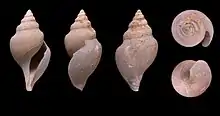| Xanthodaphne bruneri | |
|---|---|
 | |
| Shell and protoconch of Xanthodaphne bruneri (holotype at the Smithsonian Institution) | |
| Scientific classification | |
| Domain: | Eukaryota |
| Kingdom: | Animalia |
| Phylum: | Mollusca |
| Class: | Gastropoda |
| Subclass: | Caenogastropoda |
| Order: | Neogastropoda |
| Superfamily: | Conoidea |
| Family: | Raphitomidae |
| Genus: | Xanthodaphne |
| Species: | X. bruneri |
| Binomial name | |
| Xanthodaphne bruneri (Verrill & S. Smith [in Verrill], 1884) | |
| Synonyms[1] | |
|
Pleurotomella bruneri Verrill, 1884 | |
Xanthodaphne bruneri is a species of sea snail, a marine gastropod mollusc in the family Raphitomidae.[1]
Description
The length of the shell attains 22 mm, its diameter 11 mm.
(Original description) The stout-fusiform shell has a rather short, regularly tapered spire, a broad and deep posterior sinus, and a very short and wide siphonal canal. It contains seven, moderately convex whorls with a wide, concave subsutural band, which is covered with regular, strongly receding, raised lines, but destitute of spiral sculpture. The shoulder is rather prominent where the concave band joins the convexity of the whorl. The rest of the surface is covered with conspicuous, raised, obtuse, unequal revolving cinguli, separated by deep interspaces of nearly the same breadth, on the spire. On the anterior part of the body whorl the cinguli become broader and fatter, and separated by narrower grooves, which are covered by numerous rather close, raised, longitudinal lines, or lines of growth, which are less conspicuous where they cross the cinguli. This arrangement produces a finely cancellated structure, in which the spiral lines are much more distinct than the others. The aperture is narrow-ovate, continuing backward in a broad and deep sinus next the body whorl. The outer lip is thin and sharp, and projects obliquely forward in a broad curve. The siphonal canal is scarcely differentiated from the rest of the aperture. It is short and rather broad, and nearly straight. The columella is straight, with a sinuous inner margin. The inner lip extends forward on the body whorl in a broad, regular curve, defined by a thin layer of enamel. The operculum is apparently wanting. The whorls in the protoconch are eroded, but are small, regularly spiral, and without any strongly marked sculpture. The color is grayish white, with a pale yellowish green epidermis, which is easily deciduous.[2]
Distribution
The holotype of this marine species was found southeast off the Nantucket Shoals, Massachusetts, United States, North Atlantic Ocean at a depth of 3718 m.
References
- 1 2 Xanthodaphne bruneri (Verrill, 1884). Retrieved through: World Register of Marine Species on 5 April 2010.
- ↑ Verrill A. E. (1884). Second catalogue of mollusca recently added to the fauna of the New England Coast and the adjacent parts of the Atlantic, consisting mostly of deep sea species, with notes on others previously recorded. Transactions of the Connecticut Academy of Arts and Sciences, 6(1): 139-294, pl. 28-32
- Gofas, S.; Le Renard, J.; Bouchet, P. (2001). Mollusca. in: Costello, M.J. et al. (eds), European Register of Marine Species: a check-list of the marine species in Europe and a bibliography of guides to their identification. Patrimoines Naturels. 50: 180–213.
- Sysoev A.V. (2014). Deep-sea fauna of European seas: An annotated species check-list of benthic invertebrates living deeper than 2000 m in the seas bordering Europe. Gastropoda. Invertebrate Zoology. Vol.11. No.1: 134–155
External links
- Tucker, J.K. (2004). "Catalog of recent and fossil turrids (Mollusca: Gastropoda)" (PDF). Zootaxa. 682: 1–1295.